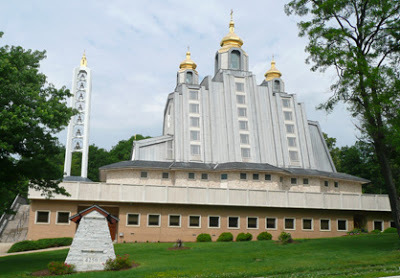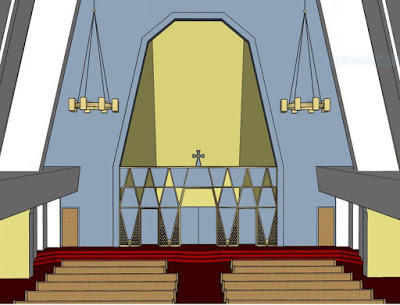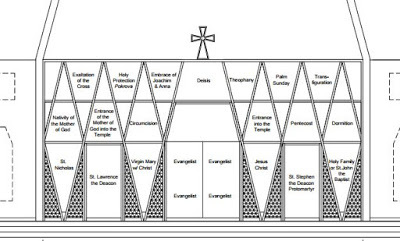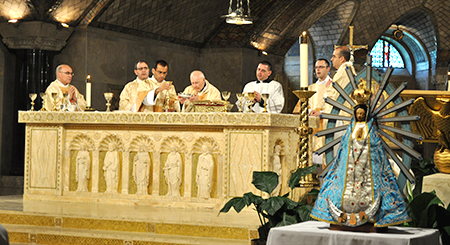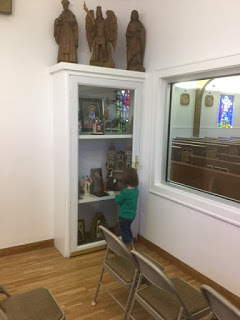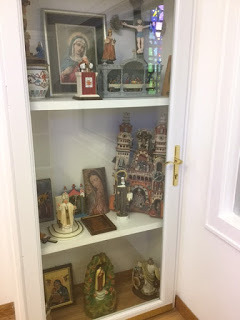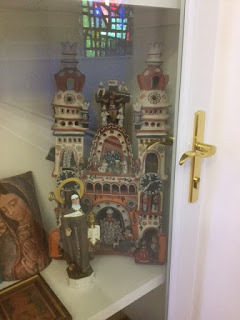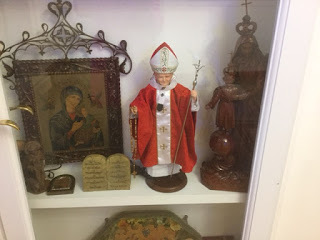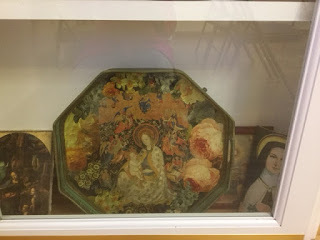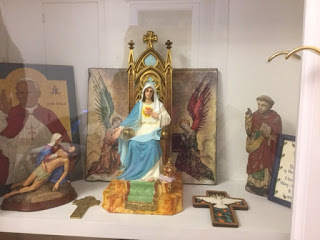David Clayton's Blog, page 13
April 18, 2016
The Walled Garden – a Poetry Collection by Andrew Thornton-Norris
I want to direct your attention to a collection poems by Andrew Thornton-Norris called The Walled Garden. It has been positively reviewed by figures known on both sides of the Atlantic such Annette Kirk, Fr Aidan Nichols, Fr John Saward and Roger Scruton who said of Andrew’s poems that they ‘convey a gentle Christian vision, pertinent to the world in which we live.’
Quarterly Review‘s Michael Davies hailed it as ‘a return to the great tradition’. You can read his detailed review of Andrew’s poems in this collection here.
Andrew Thornton-Norris’s work is accessible and noble and speaks to someone, like me, whose eye’s ordinarily glaze over at the mention of poetry – honestly, read my article The Need for Beauty and Form in Poetry if you don’t believe me. I never studied literature formerly at any level (I never did an English Literature class at high school – an omission in my education for which I am profoundly grateful).
Andrew’s poems have simultaneously the simplicity and the depth of a psalm, or an Ambrosian hymn. This is not surprising for he has a deep understanding of the connection between faith and the culture; and between the Faith and Western culture. It is because he understands both the cultural traditions of his faith, and the culture of modern man that he knows how to make the first speak within the second though his poetry.
For evidence of his understanding of the tradition, I suggest you read Andrew’s book, the Spiritual History of English. In this book he analyses the form – the underlying sentence structure and vocabulary – of the English language since the time of the Venerable Bede and he demonstrates how it has changed to reflect the culture of faith from which it emanates. As he describes modern English is less able to articulate the ideas and beauty of the faith than it was in the time of Shakespeare. You can read my review of this brilliant book in an article entitled A Book For Anyone Interested in the Evangelization of the Culture.
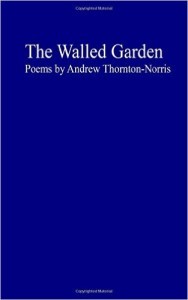 As the title of my review suggests, Andrew is not pessimistic however, and is ready to try to influence the culture through his own work and restore what has been lost and, who knows help to raise it to something even greater. This is the what all who are creative must do. As he wrote so revealingly in a recent blog post on the Beauty of Catholicism blog, ‘The modern artist or writer of faith has to inculturate his faith and work into the culture and the artistic forms of modern society in exactly the same way that a missionary has to inculturate his message into that of an alien culture. For that is exactly the circumstance that we face today, an alien culture, albeit one formed historically by our faith; and our challenge is to make our work “relevant,” comprehensible and attractive to the modern consumer of that work, without diluting its content or alienating ourselves.’
As the title of my review suggests, Andrew is not pessimistic however, and is ready to try to influence the culture through his own work and restore what has been lost and, who knows help to raise it to something even greater. This is the what all who are creative must do. As he wrote so revealingly in a recent blog post on the Beauty of Catholicism blog, ‘The modern artist or writer of faith has to inculturate his faith and work into the culture and the artistic forms of modern society in exactly the same way that a missionary has to inculturate his message into that of an alien culture. For that is exactly the circumstance that we face today, an alien culture, albeit one formed historically by our faith; and our challenge is to make our work “relevant,” comprehensible and attractive to the modern consumer of that work, without diluting its content or alienating ourselves.’
I recommend also Andrew’s course, The Romance of the Soul, which is a study of mystical poetry, including the work of poets such as Gerard Manley Hopkins, Dante, St John of the Cross, T.S. Eliot and John Burnside, which is offered at Pontifex.University. He is also a regular contributor to the American magazine, the Imaginative Conservative.
Fair Quiet, have I found thee here
The day I wandered after dusk
Across ploughed field and shadowed copse
And wondered of the busied world
If I should ever step there again.
For my heart was bleak as the plain ploughed field
And my mind was dark as the shadowed copse,
Where roosting fowl did cluck and screech
And flitting bats did dart among the flies.
Darkening skies of grey and silver and blue
With bursting coloured sunset nearly out of sight
As India from my nation’s realm withdrew
And peaceful evening skies let no respite.
By Andrew Thornton-Norris – London, United Kingdom – 19 February 2012
The painting is by Alan Thompson, and English artist.
April 16, 2016
Third Annual Catholic Literature Conference; Concord, New Hampshire, April 30th
This is an annual conference that grew out the a one-off event organized speculatively two years ago. To the surprise and delight of all involved it attracted a large and engaged crowd of people wanting to hear about and discuss Catholic literature. Now in its third year it is an established annual event. The speakers are Joseph Pearce, Gary Bouchard, William Fahey, president of Thomas More College, and Fr Michael Kerper, pastor of St Patricks’s in Nashua, NH.
For more details go to the Thomas More College site, here. You save $5 if you book before April 20th, so hurry!
It is sponsored by Christ the King Parish, Concord, and Thomas More College of Liberal Arts
April 15, 2016
Call for Icon Painters by the Ukrainian National Shrine of the Holy Family
A former student of mine, a graduate of Thomas More College in New Hampshire who is now studying at Catholic University of America and attends the Ukrainian Catholic National Shrine of the Holy Family in Washington DC has contacted me about this project. The shrine has issued a call for icon painters to undertake the painting of icons for the iconostasis and for selected walls. Go here to find out more about the commission.
The Ukrainian Catholic National Shrine of the Holy Family in Washington, DC is the face of the Ukrainian Catholic Church in the capital of the United States. Located adjacent to the Roman Catholic Basilica of the Shrine of the Immaculate Conception on the campus of CUA, and less than 4 miles from the Capitol Building of the United States of America, the Ukrainian Catholic National Shrine of the Holy Family is not only a center for worship for Ukrainian Catholics but has been built to convey information about the Ukrainian Catholic faith and about Ukrainians and their history. It has recently completed two phases of a three phases building process and are now ready to go forward with the third – the commission of sacred art for the interior.
Over 35 years, thousands of generous Ukrainian Catholics have contributed financially to the construction of the church. The shrine, designed by architect Myroslav Nimciw, was built in three phases: the lower level in 1979, the upper sanctuary shell in 1988, and the sanctuary interior in 1999. The final phase, as mentioned, is to install iconography in the sanctuary both within the structure of a new iconostas, designed by architect Larysa Kurylas, and on select walls of the sanctuary.
If you put the cursor over the lower image, above, then you will see a larger version and will be able to read the schema.
For information about the commission follow the link here.
This is an ambitious and worthy project and a great opportunity for a good icon painter. Oh that more of our Roman Rite churches would embark on such a systematic and informed process in the commissioning of art!
April 12, 2016
Institute Verbo Encarnato (IVE) – the Institute of the Incarnate Word
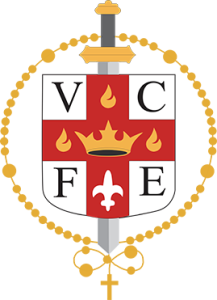 An order that embodies the principles of joyful evangelization in accordance in the spirit of Pope St John Paul the Great and Pope Emeritus Benedict XVI.
An order that embodies the principles of joyful evangelization in accordance in the spirit of Pope St John Paul the Great and Pope Emeritus Benedict XVI.
This past week, I was lucky enough to be invited to give a couple of talks on art and culture to seminarians of IVE, the Institute of the Incarnate Word. This is an order of priests, religious and of lay people (in a 3rd order) founded 32 years ago in Argentina and which has seminaries in the US (in Maryland in the Washington DC conurbation where I visited), in Italy, Brasil, Peru, the Philippines, and in Argentina. They have missions in many parts of the world including Iraq, the Gaza Strip and Papua New Guinea; and monastic foundations in Spain, Argentina, the Middle East and Italy.
My visit coincided with their 32nd anniversary on the Feast of the Annunciation (that’s how I know precisely how long they have been going).It was celebrated at the Basilica of the National Shrine of the Immaculate Conception in Washington DC. The celebrant was Bishop Quinn of Winona, MN. He and his Vicar General who flew in for the day just to celebrate Mass for IVE (IVE has a minor seminary in Bishop Quinn’s diocese). Cardinal McCarrick, Archbishop Emeritus of Washington DC spoke at the Mass (all three attended the very festive celebration meal at the seminary afterwards). This was a beautiful and dignified Mass in which the choir of seminarians and sisters from the order chanted Gregorian Mass IX for the Ordinary of the Mass and the music included beautifully sung and moving polyphony.
Before I go on, I should declare a personal bias. I became aware of them for the first time only a few months ago, because a parishioner from one of their parishes in San Jose contacted me and said that the priest there, a member of this order, was quoting my book the Way of Beauty in his homilies and encouraging people to read it because it reflected, he said, the charism of the order. Naturally I was excited and curious and got in touch, and given this interest in my book have a natural in what they are doing.
As a result of this initial contact I was asked to speak about the Way of Beauty to the priests, seminarians and sisters who live at the seminary. I was very happy to do so, of course, but my feeling as I came away from these three days I was the one who benefited the most, through my contact with them, worshiping and praying with them and through the many conversations I had.
There are so many good things I could say about my experiences in the last few days, but rather than list them all (perhaps various aspects will come out in different blog posts in time) I encourage people to read about them in their website and especially the description of their charism. My personal impression is that the qualities of joy, vigor and dignity that come through in the description of their charism is there in each person that I met. Their liturgy is solemn and dignified, their intellectual formation is rigorous and is centered on the philosophy and theology of St Thomas, and they have a special devotion to Our Lady,
Above: celebration of Mass by Cardinal McCarrick at the National Shrine of the Immaculate Conception last year. The image is Our Lady of Lujan (see below)
I want to highlight one example of what I saw that I think says a great deal about IVE. In the seminary in Washington DC there were priests, 40 or so seminarians and perhaps a similar number of sisters. I met people from Argentina, the US, Columbia, Ireland, Mexico, El Salvador, the Dominican Republic, ,Guatemala, England, and Australia that I can remember. Most were young (under 35), however, I noticed a number of men with grey hair (or very little hair) and assumed that they were long time members of the order. It was only as I started to talk to them that I found out that some were seminarians studying for the priesthood as well.
One whom I spoke to quite a bit was was 68 years old, currently a deacon and due to be ordained this May. He described himself not as a late vocation, but rather as a delayed vocation. He said that from the time he was a young boy he had wanted to be a priest and had tried several times but had been thwarted for various reasons at various early stages in the process. Latterly he was barred from being a diocesan priest because he was too old to start. He told me that IVE has a policy of never barring anyone whom they feel has a genuine vocation because of age. This was great for him – he told me he had never been happier. It was also good for the community at the seminary, I felt. It had a balancing effect on the spirit of the community. So that within each year, even the novice years, there were people with more life experience in other ways and this enriched community life for all. These are all good, practical and charitable reasons to have such a policy; but the most important reason for having such an open policy, it seemed to me, was something else. It comes from an understanding of what personal vocation is.
When we are fulfilling what God wants us to be then we contribute in charity, beautifully and gracefully to all around us. That man’s personal vocation began the moment he entered that order and was on the path that God had set out for him. This means that in the economy of grace he is giving to all around him, as well as receiving. It would be easy for IVE to think of the training period in the seminary is one in which they make the investment of money and time in his training, and only when he is ordained they start to reap the rewards. If that were so, then it would make no sense to take on older seminarians, because they won’t have time as priests to pay back the investment made in them (however you would measure such a thing). However, when the economy of grace is brought into the equation, we can see that IVE has to benefit from anyone in their presence who is living out their personal calling in life. It is an act of faith on the part of IVE that trusts in the principle that God will provide for us if we do God’s will and help others to God’s will too.
You can find out more information about IVE in the US by visiting iveamerica.org. If you want to see the home site for the organization based in Argentian (in Spanish) then that is iveargentina.org.
Below: Our Lady of Lujan, patroness of Argentina, Uruguay and Paraguay. She is the patroness of the order too. The story of the beginning of the special veneration of this image of the Immaculate Conception, dating from 1630 when a miracle occured is here. I didn’t know until I saw this image that the national flags and colors of the shirts of the national soccer teams of Argentian and Uruguay are in the colors of Our Lady of Lujan. (Perhaps England could take a leaf out of Argentina’s book, have their soccer team wear the color of Our Lady of Walsingham, and then we might win the World Cup again!)
For information on the iconography of the Immaculate Conception see and article I wrote here.
April 8, 2016
Way of Beauty Retreat in June in Rural Vermont
I have been invited by the OQ Farm in beautiful farmland close to Woodstock, Vermont) to lead a weekend retreat centered around the traditional formation that would been given to the great Catholic artists of the past. This will certainly be of interest to artists of any creative discipline; but not just artists. It is open to anyone seeking a traditional formation in beauty and inculturation that engenders creativity and openness to inspiration. It takes place from the 3-5th June, 2016.
John Paul II said in his Letter to Artists, written in 1999, that every person has a personal vocation to contribute creatively and beautifully to the culture in some way as we go about our daily lives. In that sense we might become artists through supernatural means: by being united to Christ we are transformed and participate in the divine nature. St Athanasius was referring to this supernatural transformation in the 3rd century AD when he said that, ‘God became man, so that we might become god’. Maximus the Confessor, in the 7th century AD, in reiterating this said that, ‘One becomes all that God is, except an identity in being, when one is deified by grace.’ Benedict XVI said that through this each of us can participate in the ‘creative love of God’.
It is an extraordinary privilege, yet it is one that is offered through the Church to every single person.
 This call to be raised up so that God works through us, and to contribute creatively and beautifully to society, is the essence of the New Evangelization. Through grace we lead a life of beauty and contribute creatively to a new culture. It is by this beauty and love in our lives that others see Christ and are drawn to the Faith. This result is described by Benedict in his paper on the New Evangelization, written in 2001; and in the same paper he gives us the method by which we can participate in this. The method of the ‘New’ evangelization is rooted in the one which worked so successfully for the early Church. It is a traditional pattern of prayer, which incorporates different sorts of prayer and contemplation, and has the worship of God in the sacred liturgy at its heart. This will be a journey in which together we will study this short document (under 10 pages) and try to put into practice what he describes.
This call to be raised up so that God works through us, and to contribute creatively and beautifully to society, is the essence of the New Evangelization. Through grace we lead a life of beauty and contribute creatively to a new culture. It is by this beauty and love in our lives that others see Christ and are drawn to the Faith. This result is described by Benedict in his paper on the New Evangelization, written in 2001; and in the same paper he gives us the method by which we can participate in this. The method of the ‘New’ evangelization is rooted in the one which worked so successfully for the early Church. It is a traditional pattern of prayer, which incorporates different sorts of prayer and contemplation, and has the worship of God in the sacred liturgy at its heart. This will be a journey in which together we will study this short document (under 10 pages) and try to put into practice what he describes.
This is what formed the great evangelists of the past; and it also what enabled so many of the great painters of the past to create beauty for the greater glory of God. In many ways it is building on what was described in the book written by Leila Lawler and myself, the Little Oratory – A Beginner’s Guide to Praying the Home. In this weekend we will go more deeply into the subject, learning more about how the beauty of the Catholic traditions of sacred art (as specified by Benedict XVI in his book the Spirit of the Liturgy), through form and content support the prayer life and the themes that he highlights in his paper on the New Evangelization. We will experience the methods he describes first hand the prayer that it describes, with additional insights.
As such it is a mini Catholic inculturation that you can benefit from and take with you to your domestic church. In fact the hope of this weekend is that what you get will not stop when you leave. Prayer at home, as well as in our parish church, is a vital component to what Benedict describes. Benedict told a synod on the family in 2008 that, ‘The new evangelization depends largely on the Domestic Church. The Christian Family to the extent it succeeds in living love as communion and service as a reciprocal gift open to all, as a journey of permanent conversion supported by the grace of God, reflects the splendor of Christ in the world and the beauty of the divine Trinity.’ The point should be made here that this does not only apply to families, it is true for and open to everyone, no matter what their state in life. We all have a home, and so we can all create a domestic church! It is how we turn a house into a home.
In the beautiful and peaceful surroundings of rural Vermont you will:
Learn to pray the Divine Office in English using traditional chant, so that you can do it at home or parish (no previous music training necessary)
Learn to engage with visual imagery in your prayer – in the liturgy and in devotional and contemplative prayer (conspectio divina).
Learn how to choose images, based upon traditional principle, for your own domestic church that will promote this supernatural transformation.
Understand why the great figurative traditions of the sacred art of the Church are formed so as to engender such a transformation, both through the content – what they portray; and style – how they portray it.
OPTIONS:
Weekend Retreat Package: $375 per person
Arrive on Friday, 6/3 by dinner, depart by noon on Sunday, 6/5
Includes semi-private lodging and all weekend meals. A limited number of private rooms are available for an additional cost. Please see Lodging,Travel and Meals (link) for more information.
Saturday Commuter Package: $125 per person
Arrive by 8am Saturday, joining for all daytime activities and shared lunch — departing before dinner
To book, and for more information please contact the Director of Arts Initiatives, Keri Wiederspahn: keri@oqfarm.org; 802.230.7779
Below a beautiful icon of the transfiguration, painted by monks at Mt St Angel Abbey, Oregon. This is a painting of the event that anticipated Christ in glory in heaven. It is also a painting of the mystical body of Christ, the Church. When we are transformed, in Christ, in this life, we can be a pixel of light in his body, drawing people to the Faith.
April 5, 2016
Making People Smile in the Cry Room!
 I am looking for ideas for making the church cry room - that sound proof room where you can take children and which usually has an array of toys and books.
I am looking for ideas for making the church cry room - that sound proof room where you can take children and which usually has an array of toys and books.This has been inspired by photographs sent to me by friends who spent Easter at St. William’s parish in Greenville, Texas. They were struck by the effort that the priest, Fr Paul Weinberger had made to make the cry room holy.
As Sherri wrote to me: ‘The cry room is pretty small, but Fr. Paul has managed to fit in a lot for the little ones to examine, and it really adds a sense of holiness to the room.
‘How simple but clever to put everything behind locked glass storm doors, so it is both accessible to the kids for viewing and yet safe from little hands. It’s like a tiny museum! Besides the items behind glass, there are wooden statues of saints and Angels on the top of each cabinet, keeping a watchful eye on the kids.’
George and Katy Rose are the boy and girl in photos. It takes something pretty powerful to keep young George quiet, I know, so Fr Paul must be getting something right.
So, if anyone has anything interesting from their cry room, send the photos along!

March 31, 2016
International Conductor to Address Catholic Artists’ Society in NYC
The Catholic Artists’ Society series, Art of the Beautiful, concludes on Tuesday, April 5th, at 7 PM, with a talk by conductor Manfred Honeck, music director of the Pittsburgh Symphony Orchestra.
Born in Austria, Honeck has worked to great acclaim with the world’s leading orchestras including the Berlin Philharmonic, Vienna Philharmonic and the London Symphony Orchestra, . In the United States, Honeck has conducted the New York Philharmonic (with whom he is appearing next week), The Cleveland Orchestra, Chicago Symphony Orchestra, Los Angeles Philharmonic, Philadelphia Orchestra and Boston Symphony Orchestra.
His talk is entitled “Faith in Music.” A reception and sung Compline will follow.
March 29, 2016
March Adoremus Bulletin
The latest edition of the Adoremus Bulletin is now out; you can read it online here.
This is a particular rich and attractively designed issue. The Adoremus Bulletin does really seem to have new vibrancy to it under the leadership of the new editorial team of Chris Carstens and Joe O’Brien. Highlights include an article about the mystagogy of the Lamb of God by editor Chris Carstens, supporting another article which analyses the Ghent altarpiece, also known as the Adoration of the Mystic Lamb, as liturgical art; that is, how do its form and content work in the context of the liturgy? The Ghent altarpiece is the second most viewed painting in history, and the article has been prompted by the release of a book about the painting, a 15th century by the Van Eyck brothers, published by Magnificat.
There is also an excellent review, written by Mr Jeremy Priest, of Uwe Michael Lang’s new book Signs of the Holy One, published by Ignatius, which is a meditation on the assertion that the non-verbal symbols associated with the liturgy are more significant than the language itself. Follow link here to read it.
March 25, 2016
Quantum Physics and Austrian Economics, How the Two Are Connected
and how that connection reinforces the truth of the Catholic Faith.
Here are two books, covering what at first sight are unconnected topics, in which leading figures in their respective fields explain how each is consistent with Catholic teaching.
 First, Modern Physics, Ancient Faith by Stephen M Barr. This is the best book about science and faith that I have ever read, bar (if you’ll forgive the pun) none. It is often supposed that science and faith are in conflict with each other. I have found that both people of faith and people who do not believe in God can hold this erroneous view (which in Christians leads, for example, to an irrational suspicion of science, of the industrial revolution and of modern medicine; which in turn reinforces a false view of religion by non-believers that it is simply superstition that rejects science and reason).
First, Modern Physics, Ancient Faith by Stephen M Barr. This is the best book about science and faith that I have ever read, bar (if you’ll forgive the pun) none. It is often supposed that science and faith are in conflict with each other. I have found that both people of faith and people who do not believe in God can hold this erroneous view (which in Christians leads, for example, to an irrational suspicion of science, of the industrial revolution and of modern medicine; which in turn reinforces a false view of religion by non-believers that it is simply superstition that rejects science and reason).
In this book Prof. Barr, who is a research physicist, lucidly explains how the conflict is not between science and faith, but between faith and the philosophy of scientific materialism. (Scientific materialism says that only science which is an investigation of the material world, can demonstrate truth).He is not the first to explain this, although the book is worth reading just for his clarity on the subject.
It is when Professor Barr goes on to explain advances in physics since the turn of the 20th century that this book becomes most interesting. He describes how these advances consistent with traditional ideas about the cosmos as articulated by the Fathers of the Church in a way that classical physics up to the 19th century was not. Also, as he explains, these advances formulated by figures such as Albert Einstein and Nils Bohr,actually undermine traditional scientific materialism as a philosophy. He considers about half a dozen developments in past classical science, looking for example at Big Bang and quantum physics, and explains in layman’s terms what characterizes them and then demonstrates how they reinforce the Faith of the Church Fathers. Modern Physics, Ancient Faith is very clear and readable. If I had my way, I would make it part of the core curriculum of every general Catholic education.
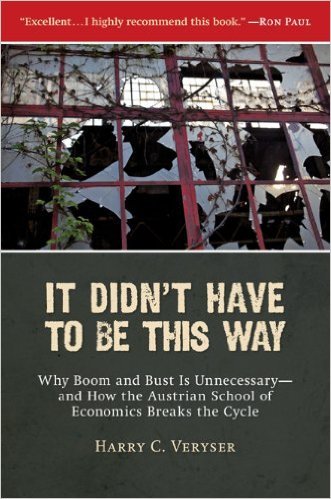 Second is an introduction to a form of free market economics called Austrian economics by the economist Harry Veryser. His book is called It Didn’t Have to Be This Way: Why Boom and Bust is Unnecessary and How the Austrian School of Economics Breaks the Cycle. Professor Veryser – head of the Masters program in economics at Detroit Mercy University. Veryser is also a committed Catholic and he explains also how in his view this economic system is consistent with a Christian anthropology, is build upon the understanding that a flourishing culture of faith is important for society, and if introduced will allow the human person to flourish in accordance with Catholic social teaching. I wrote a review of Veryser’s book, here, which also appeared in the journal of faith and culture, Second Spring.
Second is an introduction to a form of free market economics called Austrian economics by the economist Harry Veryser. His book is called It Didn’t Have to Be This Way: Why Boom and Bust is Unnecessary and How the Austrian School of Economics Breaks the Cycle. Professor Veryser – head of the Masters program in economics at Detroit Mercy University. Veryser is also a committed Catholic and he explains also how in his view this economic system is consistent with a Christian anthropology, is build upon the understanding that a flourishing culture of faith is important for society, and if introduced will allow the human person to flourish in accordance with Catholic social teaching. I wrote a review of Veryser’s book, here, which also appeared in the journal of faith and culture, Second Spring.
So, aside from the obvious – two Catholic authors seeking to demonstrate how their respective fields are in accord with the Faith – what is the connection between these two books?
The answer, I suggest, lies in the way that each is describing how a predictable order emerges out of a series of a large number of individually unpredictable events.
So in the case of Veryser’s economics: he describes how even though the individual decisions are made by human beings and are subject to free will (and in the ideal, free will properly ordered to our supernatural end) and as such are not predictable by science; when the economy as a whole is observed a describable order emerges. So the patterns of society as a whole, even though it consists of the aggregate of this network of personal relationships and choices that are based in free will, do follow a consistent pattern of cause and effect. It is a paradox – that although the component decisions and relationships of which society and a culture comprise do not conform to any describable order, the aggregate effect does, provided that you have enough events for statistics to apply.
Veryser does qualify this. In the 19th century, when this pattern was first noticed, there was a tendency to treat the field of economics as a precise science. This stream of thought in economics persists to this day, taking the parallels between classical physics and economics to far, he says. According to Veryser, although general trends can be predicted well enough to allow for prudent implementation of economic policy, economics is still not a sufficiently precise science to enable the effects to be quantified mathematically in the way that a scientific theorem quantifies the natural order in the material world. In short, while we can predict what will happen we cannot say exactly how much. This over reliance on mathematics in economics was a mistake that has had disastrous consequences. Part (not all) of the cause of the economic collapse of 2007-8, Veryser tells us, was due to the fact that some economists (from Milton Friedman’s Chicago school of economics) put too much emphasis on the mathematical predictability of the economy and this encouraged bad investment decisions. When these investments crashed, the economy as a whole was so dependent upon their viability, that it crashed too.
Veryser suggests that economics can’t be treated as a science because such an approach ignores the human aspect of free will and the cultural milieu that influences those decisions. Austrian economics works so well, he says, because it does take these into account.
I suggest that the problem with the Chicago school was not that it tried to apply scientific principles to the economy as a whole, but rather that it relied an antiquated scientific approach to quantify its predictions. It looked to 19th century classical physics as a model of analysis; rather than looking to quantum physics. In order to explain why quantum physics might have relevance to economics, I will have to try to explain first how quantum physics is different from classical physics which was the established scientific orthodoxy from the time of Newton until the end of the 19th century.
In classical physics, the assumption had always been that all matter conforms to exactly the same physical laws, no matter how large or small those pieces of matter are. Over time, as scientific knowledge progressed, the horizon of observation and analysis became smaller and smaller. What began as the observations of large scale bodies, for example planets and stars in the sky, became focused as well on matter broken up into its constituent parts , for example atoms, and sub-atomic particles such as neutrons, protons and so on. Provided the particles being observed weren’t too small then it seemed that this assumption of the universality of the laws of physics seemed to hold. However, as the analysis became finer and finer and smaller sub-atomic particles, such as quarks, were discovered, things started to break down. It was discovered that the constituent parts of which all matter is made don’t seem to behave in exactly the same way in isolation as the large scale bodies that they comprise. Quarks seem to follow a whole new order.
I can remember when I was at school at around 16 years old being struck by the strangeness of this when learning about the pattern of decay of radioactive atoms (by which an atom splits up to form two or more lighter elements and simultaneously releases radiation). My teacher told us that when you look at a sample of uranium the rate of decay of the whole lump can be predicted quite accurately (by calculating something called a half life, which is a set time that it takes for the mass of the lump to reduce by half and is always the same for any radioactive element). However, for all the certainty associated with the activity of the sample as a whole, if you were to consider any one atom within that sample, things look different. If we were able to select one particular atom for consideration we would have no idea at all when it will decay. All we can say is that at any moment there is a probability of decay occurring. Once you know this probability, if you have many many atoms then you can say that statistically, a proportion of them will have decayed at any given time. So for example, if the chance of a single atom decaying is in a given time period is 1 in 10,000, and we have 1,000,000 atoms, we can say that it is likely that in that time period, 100 ( ie a 10,000th of a million) atoms will have decayed. We still can’t predict which 100 atoms it will be , but we can say it is likely to be that number. The statistics become more accurate the greater the number of atoms in the sample. So by the time we get to a visible lump of uranium which will contain trillions and trillions of atoms, the rate of decay of the whole lump can be predicted quite accurately. This is the paradox of quantum physics, the pattern of behaviour at the sub-atomic level is different from the order that emerges when you have trillions of those particles together and you look at the aggregate effect. The aggregate effect conforms to classical physics – that is on the large scale classical physics still holds; but the behaviour of all the smallest particles within it seems to follow a whole different pattern, even though it is these particles that are contributing to the aggregate effect.
The degree to which the body exhibits quantum or classical behaviour depends upon the number of particles present. For a single particle it is pure quantum behaviour, as the number of paticles increases you have what is called an ‘emergent order’ in which the mode of behaviour steadily becomes closer to classical physics. If the sample is large enough, many trillions, then the statistics are more accurate and classical physics holds. Between the two extremes therefore, there is a transitionary stage of partial quantum and partial classical behaviour.
Furthermore, and here is what is all the more amazing for me, the pattern of behavior of the sub-atomic particles when purely quantum, is mathematically inconsistent with any possible mechanical process. So its not just that we don’t know what causes that radioactive to decay when it does; we can say that from the mathematical pattern of that decay, the cause is not consistent with any conventional mechanical cause as one would expect to see in natural order. This means that the quantum event, for example the decay of an atom, might be spontaneous, or it might have a cause that does not originate in the material world. In other words when we get down to the first individual events in the chain of events (that collectively conform to classical physics), we see something that has a pattern that might, hypothetically be caused by something non-material. This non-material cause could, hypothetically, be something spiritual such as a human will, or a divine will; or it could be something else totally different, as yet unknown, perhaps even unimagined, and still to be discovered.
If the cause were spiritual, then it allows for the possibility that the motion of electrons in the brain is the result of the thought connected with it (as traditional anthropology which sees man as body and soul would suggest) and not the cause (as a secular materialist would insist). Another possibility is that the divine will, God, really could be the First Cause for all physical processes. We should take care, however, in stating this that we do not to fall into the God of the gaps error. Saying that something is consistent with the existence of a will, either human or divine, is not the same as saying that it proves that it is so. Future research might confirm this either way; but as it stands, quantum physics does cause big problems for the traditional secular materialist viewpoint which relies on classical physics alone to prop it up. Amusingly, Barr describes how quite a few scientists who hold to secular materialism have responded to this challenge to their ‘faith’. Rather than acknowledge the possibility of the legitimacy of hypotheses that there is a God, atheist scientists come up with a whole string of just as unverifyable scientifically, and far less credible hypotheses such as the multiple universes (if you want to understand more about this you’ll have to read Barr’s book).
Now back to Austrian economics. It occurred to me as I read Veryser’s book, that Austrian economics is, contrary to what Veryser thought, consistent with science. Veryser was right in pointing out that its methodology was not consistent with 19th century, classical science; but what he did not realise, perhaps, is that it is consistent with quantum science. We can see that once we adopt a quantum physics view of science, we can see that both inanimate matter, and human society exhibit the same pattern of random behaviour at the individual or quantum level, with an emergent order when the aggregate effect is considered.
However, the sample has to be large enough for the statistics to work and for the mathematics to apply. The population of the whole world is a tiny fraction of the number of atoms in even a small sample of uranium so we never see the full equivalent of classical science in a human society. The number of human decisions made in a typical economy seems to be sufficient only for that order to be partially emergent so that general trends are predictable, but not sufficiently so for precise mathematically calculation to be applicable. This was the problem for the Chicago economists approach, the sample size just wasn’t large enough.
If I am right and there really is a parallel between Austrian economics and quantum physics, and each is consistent with the Faith in the way that Barr and Veryser describe, it opens up, potentially, a natural connection between the social sciences and the physical sciences in which a free man has a place to flourish. It is all hypothetical at this stage (and who knows where scientific progress will take us next) but for the moment at least it seems that deep down in the heart of all matter there is a place the division between the natural and the supernatural; and the spiritual and the material is blurred.
This being so, the Christian has no need to feel that science and its daughters, technology and industrialization are somehow in conflict with an appreciation of the human person as body and soul. It is classical science that caused this conflict. It is not just Christians who have agonized over this. For example, ever since the 1920s there has been a whole genre of films based upon a sense that a society is too technology driven and as a result is impersonal and inhuman. These films portray a future society in which scientific materialism has its day and man is reduced to an automaton. Typically the hero is the passionate man whose love for a woman bucks the trend and brings the whole system of mechanical society crashing down. Earlier cultural movements have emerged from this same pessimism. The arts and crafts movement looks back to the halcyon days of the beauty of a pre-industrial age and concludes that technology and industrialization are the cause of modern ugliness. Both of these cultural expressions have at their roots a suspicion of scientific progress and a belief that it always suppresses the human spirit and stultifies a culture of faith and beauty and both, I would say that in this respect both are wrong. The answer is not to remove modernity, but to transform it, make if fully what it ought to be.
It seems if we want to have a free society, that the answer is not to eliminate or be suspicious of science, rather we should welcome scientific progress and seek to understand it more deeply so that it is in harmony with Catholic social teaching – the two are not mutually exclusive. Such a society will in turn inform technological and industrial advances that respect man’s freedom; and such a society will also engender and support a culture of faith and beauty more powerfully than ever before.

As I argue in my book, the Way of Beauty, the greatest influence on the culture and the creation of community in society is our attitude to God, and the greatest influence on that is our worship (and not capitalism, industrialization or mass production). To the degree that the culture is informed by faith, then the free economy, such as that advocated by Austrian economists, will allow a greater flourishing of man. How can we move towards this society? The answer lies in cultural transformation even before the changing of legal, political or economic systems (although I am not against attempts to change these too). It is in the Eucharist, at the heart of the sacred liturgy, which is the node at which the material and the spiritual, the natural and the supernatural, human and the divine, and the eternal and the temporal all meet at the deepest level and in the most profound and harmonious way. It is a supernatural transformation in Christ, through a d full and active participation in the sacred liturgy that we are transformed and become people who through our daily activity transform the culture around us. One can’t help feeling that the mysteries that recent developments in science seem to be hinting at are fully encapsulated at that point and the fullest knowledge of them is only grasped through a gift of divine wisdom. The liturgy is the source and summit of human life and that includes, it seems, the greatest source of inspiration for scientists, social scientists and economists!
Above, top: a scenes from the 1927 film Metropolis; and a promotional poster from the 1960s cult TV series, The Prisoner; Elevation of the Host, with vision of St John of Matha, painting by Juan Carreño de Miranda, 1666
March 21, 2016
Creating a Courtyard for Contemplation Out of an Alleyway
I was walking through downtown San Francisco this morning on one of the busiest streets in the city center and I noticed this little alleyway to my left.
What caught my eye is how with very little of architectural interest to work with, a few well tended plants have turned the space into a tiny little peaceful oasis in a busy city. It could have been piled high with garbage bags or the like (others I saw were) but someone has made the effort to make this little corner worth looking at. And everyone who passes, not just those who live and work down here can now have the pleasure of looking at the results of their work.
All it would need to perfect it would be little icon of Christ on the back wall, or perhaps a statue of the BVM, and a place of peace might even become a place of contemplation!
The cobblestones help too of course!
David Clayton's Blog
- David Clayton's profile
- 4 followers





